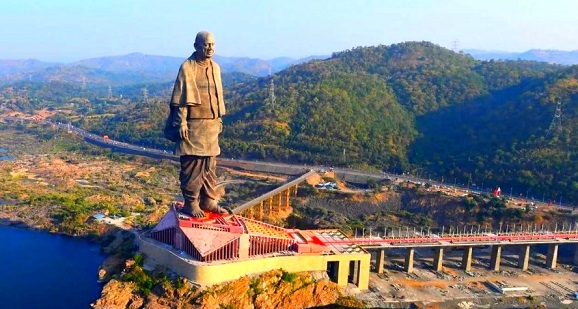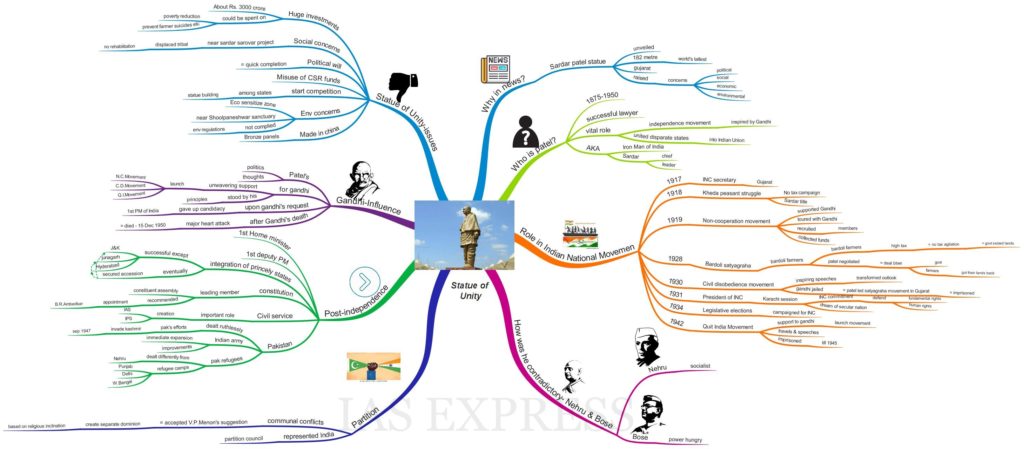Sardar Vallabhai Patel – Biography and Contributions

From Current Affairs Notes for UPSC » Editorials & In-depths » This topic
IAS EXPRESS Vs UPSC Prelims 2024: 85+ questions reflected
Who is Sardar Vallabhai Patel?
- Vallabhai Patel (1875-1950) was a political and social leader of India who played a vital role in India’s struggle for independence and subsequently helped its integration into a united as well as an independent nation.
- He was called the “Iron Man of India”, and was often addressed as “Sardar” which means “chief” or “Leader” in many languages of India.
- Patel was a successful lawyer and he entered the Indian national movement after he was inspired by the work and philosophy of Mahatma Gandhi.
What was his role in the Indian National Movement?
As INC secretary: In 1917, Sardar Vallabhai Patel was elected as the Secretary of the Gujarat Sabha, the Gujarat wing of the Indian National Congress.
Kheda Peasant Struggle: In 1918, he led a massive “No Tax Campaign” to ask the farmers not to pay taxes after the British insisted on tax after the floods in Kheda/Kaira, Gujarat.
- The peaceful movement made the British officials to return the land taken away from the farmers.
- His effort in this campaign to bring together the farmers of his area got him the title of ‘Sardar’.
Non-cooperation Movement, 1919-21: He actively supported the non-cooperation movement launched by Gandhi. Patel toured the country with him, recruited 3 lakh members and helped collect over Rs. 1.5 million.
Bardoli Satyagraha – In 1928, Bardoli farmers faced a problem of increase in tax rate. Farmers refused to pay the extra tax = the government seized their lands in retaliation. The agitation prolonged more than 6 months. After several rounds of negotiations by Patel, a deal was struck between the government and farmers’ representatives = lands were returned to farmers.
Civil Disobedience Movement: In 1930, Sardar Patel was among the leaders jailed for taking part in the famous Salt Satyagraha Movement launched by Gandhi. His inspiring speeches during the Movement transformed the outlook of several people, who later played a major part in making the movement successful. When Gandhi was put into jail, Patel led the Satyagraha movement across Gujarat. Later Patel was also imprisoned.
As President of INC: Patel was freed in 1931, after an agreement signed between Mahatma Gandhi and Lord Irwin, the then Viceroy of India. The treaty was popularly known as the Gandhi-Irwin Pact.
- The same year, Patel was elected as the President of Indian National Congress in its Karachi session where the party deliberated its future path.
- In this session, the Congress committed itself towards defence of fundamental and human rights. It was also in this session that the dream of a secular nation was conceived.
1934 Legislative Elections: During this, Sardar Patel campaigned for the INC. Even though he did not contest, he helped his fellow party members during the election.
Quit India Movement 1942: Patel continued his unwavering support to Gandhi when many contemporary leaders criticized the latter’s decision to launch the movement.
- Patel travelled throughout the country propagating the agenda of the movement in a series of heartfelt speeches.
- He was arrested again in 1942 and was imprisoned in the Ahmednagar fort till 1945 along with other Congress leaders.
How was he contradictory to Nehru and Bose?
- Patel’s journey often saw a number of confrontations with other important leaders of the Congress.
- He openly voiced his annoyance at Jawaharlal Nehru when the latter adopted socialism in 1936.
- Patel was also wary of Netaji Subash Chandra Bose and considered him to be “keen on more power within the party”.
Sardar Patel and the Partition of India
- The separatist movement led by Muslim League leader Mohammed Ali Jinnah resulted in a series of violent Hindu-Muslim riots all over the nation just before the independence.
- In Patel’s opinion, the open communal conflicts propelled by the riots had the potential to create a weak government at the Centre after independence which will be disastrous for consolidating a democratic nation.
- So Patel started working on a solution with V.P.Menon, a civil servant during December 1946 and accepted his recommendation of establishing a separate dominion with respect to the religious inclination of states.
- He also represented India in the Partition Council.
What were his contributions to Post-independence India?
As Home Minister: After India achieved independence, Patel became the 1st Home Minister and also the Deputy Prime Minister.
Integration of India: Patel played a very important role in post-independence India by successfully integrating around 562 princely states under the Indian Dominion.
- The British Government had given the rulers of princely states with 2 options – they could join India or Pakistan, or they could stay independent.
- This clause made the integration process all the more difficult.
- Congress entrusted this daunting task to Patel who started the campaign for integration on August 6, 1947.
- He was successful in integrating all of the princely states except J&K, Junagarh, and Hyderabad. But eventually dealt with the situation with his sharp political skills and secured their accession.
- Therefore, the India that we see today was a result of the efforts put in by Sardar Vallabhai Patel.
Making of Constitution: Patel was a leading member of the Constituent Assembly of India and Dr. B.R. Ambedkar was appointed on his recommendation.
Civil Service: He played an important role in establishing the Indian Administrative Service and the Indian Police Service.
Dealing with Pakistan:
- Patel dealt ruthlessly with Pakistan’s efforts to invade Kashmir in September 1947. He oversaw an immediate expansion of the army and made improvements in other infrastructural aspects.
- He often disagreed with Nehru’s policies, particularly about his dealings with Pakistan regarding the refugee issues.
- He organized many refugee camps in Punjab, Delhi and later in West Bengal.
How was he influenced by Mahatma Gandhi?
- Gandhi had a huge effect on Patel’s politics and thoughts.
- He pledged unwavering support to Gandhi and stood by his non-violent principles all through his life.
- While leaders like Nehru, C.Rajagopalachari and Maulana Azad criticized Gandhi’s idea that the Civil Disobedience Movement would drive the British out of the country, Patel provided his support to Gandhi.
- Despite the unwillingness of the Congress high command, Gandhi and Patel forced the All India Congress Committee to ratify the civil disobedience movement and launched it without delaying further.
- Upon Gandhi’s request, he gave up his candidacy for the post of the Prime Minister of India for Jawaharlal Nehru.
- He suffered a major heart attack after Gandhi’s death and the great soul left the world on 15 December 1950.
Awards and Honours
- Sardar Patel was posthumously conferred the Bharat Ratna, India’s highest civilian honour, in 1991.
- His birthday, October 31, was declared Rashtriya Ekta Divas in 2014.
Practice Question
- Examine the contributions of Sardar Vallabhai Patel towards post-independence consolidation.


